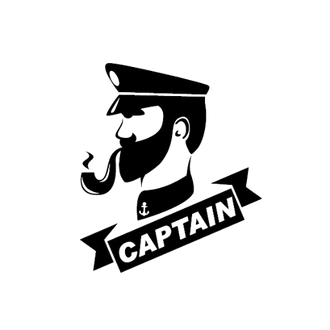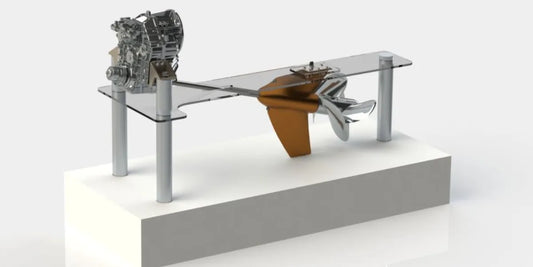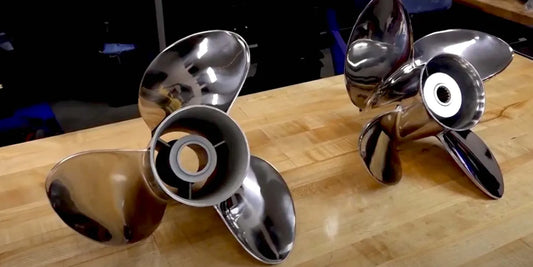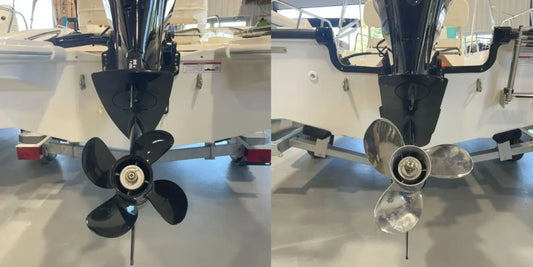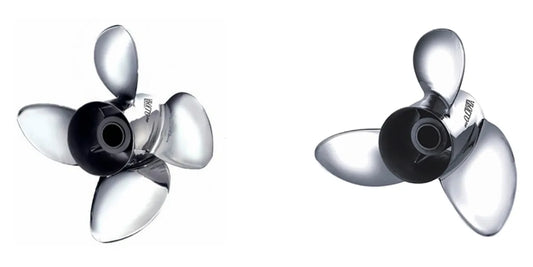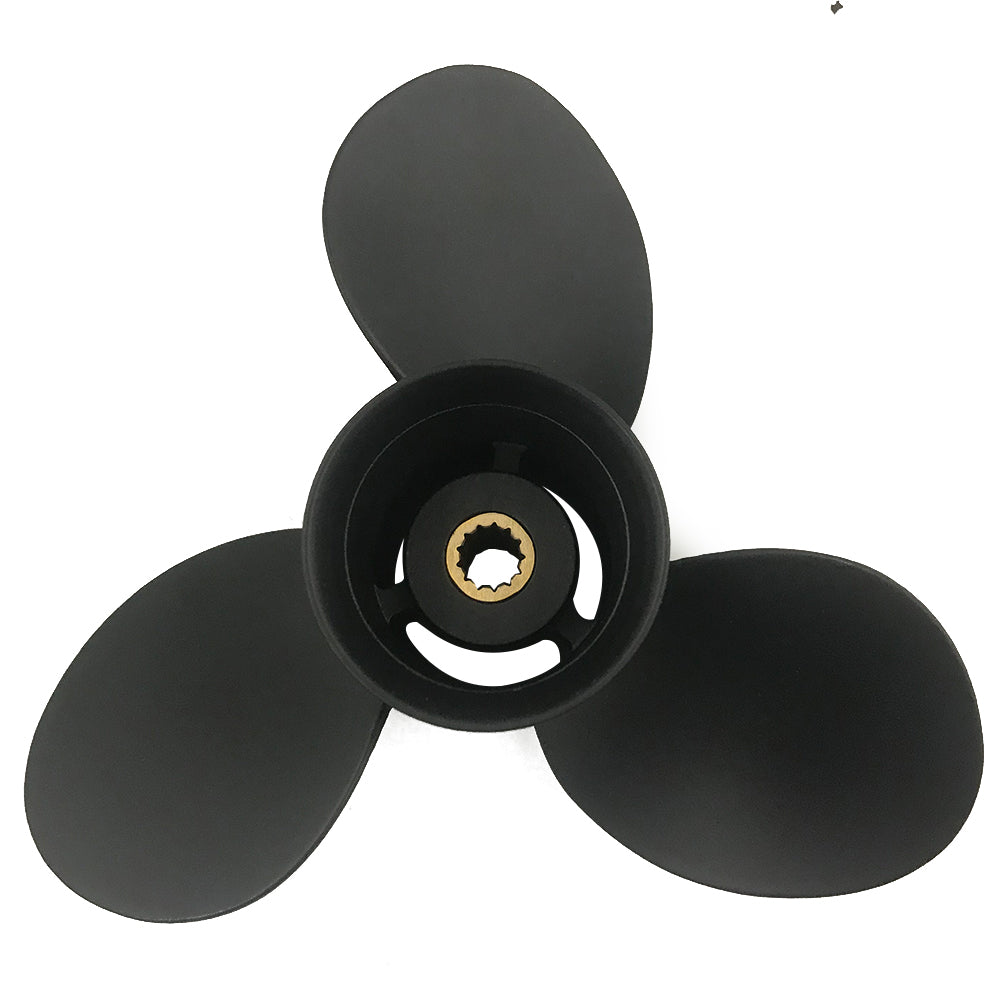Maxing out performance on a Suzuki outboard often starts with the propeller you bolt on the lower unit. Even a casual weekender will tell you that the right blade can quietly change a boat's speed, steering, and thirst for fuel. The coming pages detail that choice, laying out the options, the tech, and the trade-offs. Look at diameter-versus-pitch math, stainless versus aluminum health warnings, and factory specs no one ever reads. By the final paragraph, you'll have a strategy for pushing your hull a little farther, a little faster, and probably with less worry.
What Are the Different Types of Suzuki Outboard Propellers?

Understanding the Aluminum Propeller Options
Aluminum propellers are prominent in the marine marketplace, and affordability is one reason why. Most weekend anglers or casual cruisers are drawn to the low upfront price. Yet, they stay for the material's unexpected blend of lightweight, strength, and on-water respectability.
Corrosion-resistant paints or anodized finishes now coat nearly every factory blade, so the brackish water of a boat ramp does not eat metal for lunch quite as quickly as it used to. Minor nicks and bends, which inevitably happen at the dock, can usually be hammered out or welded without a second mortgage, leaving a modest service bill instead of an invoice for an entire stainless-steel wheel.
Moderate-speed hulls, think pontoons or 16-foot runabouts loaded with fishing gear, find a natural partner in aluminum, even if the blades tend to flex under max throttle. That flex costs a handful of RPM at the top end, yet daily cruising, wakeboarding, or short-haul towing chores hardly feel the penalty. The industry responds by stocking offsets in diameter, pitch, and rake, letting a boater dial in bite and slip to match whatever cowling is underneath.
As a rule of thumb, light to mid-range workloads pair best with aluminum, especially when the outboarder favors economical running over Scale 10 hurry. Heavy towing, salt exposure, or full-throttle water-skiing days still lean toward stainless for forgiveness on torque spike, yet nothing in recreational boating needs drama every hour of the weekend.
Exploring Stainless Steel Propeller Variants
Stainless steel propellers have earned a reputation among seasoned boaters for their tough-as-nails construction and the bite that aluminum simply can't match. Shipped off the lathe in a compacted sheet of marine-grade steel, each wheel shrugs off salt, sand, and electrolysis the way leather boots repel afternoon rain. The metal's inherent stiffness means the blades stay eerily straight even at wide-open throttle, so steering feels precise rather than spongy, and fuel burn eases back because the engine wastes less energy on blade torque.
Serious anglers, workboat crews, and weekend tow-ski families drift toward stainless when payload, rough water, or elapsed time is non-negotiable. Four-blade and five-blade patterns are common on dealer walls, letting prop-sellers tint the wheel for quick lift, heavy bottom feel, or glass-plate calm. That design buffet allows every captain to dial in pitch and offset the exact torque curve of a personal outboard or diesel leg.
Manufacturers keep reshaping the leading edge, gutting the blade root, and polishing the hub so cavitation bubbles scatter quickly and shut up before they erode. Independent wind-tunnel numbers keep ticking toward a 5-to-10 percent efficiency gain over mid-grade aluminum when the tach sits above 4000. Sticker shock arrives first, but owners soon stop replacing dinged blades; over five seasons, the ledger tiptoes black, and the prop sits polished, waiting like a favorite tool.
Comparing 3-Blade Aluminum vs. 4-Blade Designs
Traditionally, many boaters reach for a three-blade aluminum prop when their main goal is to go fast. The lighter disc cuts drag pretty well, leaving the engine almost like it is spinning in free air. On a light hull, the outcome is a lively top end that, and just as important, frees the fuel gauge on long hauls across glassy water.
Four-blade wheels, by contrast, are engines on a very different mission. The extra blade surface digs in hard, keeps a heavy hull pinned to the planing threshold, and moors the boat steady when wind and chop start jabbing. Operators who tow skiers, haul fish boxes, or just want smooth, hands-off steering often rank the four-banger as indispensable even if that choice nudges peak speed southward by a few knots.
Curiously, several side-by-side trials have hinted that the four-blade delivers better fuel numbers at the slower cruise most families call home. The wider effective diameter keeps the revs happier and, in many cases, guards against gut-punch vibration that can age a backseat passenger long before a captain feels it. Picking between the two designs boils down almost entirely to how and where the boat will spend its waking hours.
How to Choose the Right Propeller for Your Suzuki Outboard?

Factors to Consider: Pitch and Diameter of Propellers
Choosing the right propeller for a Suzuki outboard starts with appreciating pitch and diameter, the twin variables that shape nearly every performance trade-off. Pitch is the distance, measured in an imaginary straight line, that the blade would cover in one full turn if slippage did not occur. A prop with a high pitch can coax a boat to greater top-end speed, yet often leaves it sluggish off the mark and may over-stress the powerhead at low RPMs. Lower pitch, in contrast, quickens take-off and improves low-speed handling, though that same prop usually runs out of steam at wide-open throttle.
Diameter measures the circle's width traced by the blades at full rotation, which matters more than many first-time buyers realize. Broader blades can bite into a larger column of water, making them ideal for heavy boats or hulls requiring brute thrust to climb onto a plane. Narrower discs, by contrast, favor lightweight craft, allowing them to spin at higher RPMs and turn on a dime without porpoising.
No compromise works for every application, so the eventual selection must reflect the boat's weight, the outboard's horsepower curve, and the skipper's typical cruising style. A working fishing skiff that lingers at 2,500 rpm while shuttling between docks will probably outperform with a prop that mates low pitch and generous diameter, maximizing fuel economy and in-gear responsiveness. Rounding up this due diligence turns the propeller selection into a calculated decision rather than blind trial-and-error, aiming for brisk handling and long-lasting reliability.
The Role of Engine Power and RPM in Propeller Selection
Horsepower ratings and RPM figures sit at the center of any sensible propeller decision for a given boat. The engine must generate enough muscle for the blades to bite without bogging down or spinning uselessly in the air. If either torque or rotational speed wanders far from factory targets, efficiency vanishes, and components complain.
Most mechanics advise that a skipper choose a prop capable of coaxing maximum engine RPM right at the manufacturer's ceiling. Anything smaller in diameter or taller in pitch will yank the revs downward, forcing the power unit to pitch a quiet hiss rather than a full roar. Flip the situation-arbitrarily large blades, say-and the crankshaft howls past redline, cooking oil, seals, and reputation all at once.
Field trials repeatedly show a two-hundred-horse rig, properly partnered with its blades, leaps onto a plane faster and sips fuel like a cautious sedan. Extras like two-piece shafts or adjustable-pitch heads let the crew dial back the bite when gear, ice, or spirited sea state weigh in with attitude. Measure horsepower against that trusted RPM band, and the ride will remain clear of labored groans and costly overnight waits in the slip.
Understanding Thrust and Efficiency
Thrust, the clear push a propeller gives to a boat, is the first number anyone looks at if speed and fuel bills matter. Its strength rides on many moving targets: blade shape, diameter, pitch, total area, and horsepower behind the assembly. Nudging the surface area upward can deliver a satisfying jolt of thrust, yet that same tweak drags extra water and gulps more fuel. Fine adjustment of pitch, the imaginary distance a blade travels in one whole spin, changes the game again. Broadly set pitch yanks a heavy hull forward in seconds, and a tight pitch coasts the hull farther on each gallon burned.
Efficiency is less about brute power and more about not wasting the power you already have. When pressure spikes shift suddenly inside the water, vapor cavities, or cavitation bubbles, cork progress and smudge the efficiency ledger. That is why racers pay extra for cupped contours or blade vents that chop the pressure edge before it bites. Even the best geometry runs uselessly wide if engine RPM sits outside its handy range, that sweet spot where every drop of fuel feels productive.
The interaction of thrust, drag, and available power effectively governs a vessel's conduct across the water. Captains who grasp this balance can tailor their operating envelope to pursue economical range on extended passages or dial in spirited response for wakeboard runs and tow-behind fun.
Why Upgrade to a Stainless Steel Propeller?

Benefits of Enhanced Durability and Performance
Choosing a stainless-steel propeller is, at its core, a decision based on longevity. The material shrugs off dents and pitting far more readily than aluminum, and that toughness pays dividends in brackish or open-salty seas. Because stainless steel holds its shape even under punishing impacts, engineers can sculpt the blades into sleek, hydrodynamically efficient profiles.
That thoughtful geometry translates directly to the feel of the throttle. Many skippers report noticeable jumps in raw speed and crisp, lane-tight handling, all while the fuel gauge hesitates. For anyone tired of yearly repairs and willing to invest once rather than repeatedly, moving to a stainless-steel wheel is not just sensible; it is outright strategic.
Impact on Acceleration and Top Speed
The innate strength of stainless steel allows manufacturers to forge propellers that neither bend nor deform under heavy load. This rigidity funnels nearly all of the engine's torque into forward motion and produces the sharp, forceful bite that water skiers and towboat operators instinctively seek. By retaining their engineered profile, marine-grade stainless blades deliver a brisker, more immediate punch out of the hole.
A second advantage lies in streamlined drag. Field trials across salt, brackish, and freshwater venues repeatedly confirm that comparable stainless units can edge by 2 to 3 mph once any cruise threshold is passed. Such consistent uplift inevitably tips weekend racers toward the more expensive alloy, since every fraction of speed translates directly into competitive advantage.
What Are the Best Suzuki Outboard Propellers for Specific HP Ranges?

Top Choices for Suzuki 150-300 hp Engines
Choosing a propeller for a Suzuki 150-to-300-horsepower outboard engine means more than bolting on an aftermarket blade. Boaters routinely cite build quality, responsiveness, and perfect fit as moving targets that can make or ruin a day on the water. Many professionals settle on stainless steel because the alloy refuses to flex or corrode even in salt-soaked environments, and the OEM Suzuki stainless offerings tend to disappear from dealer racks for good reason. Those Suzuki-branded wheels flaunt carefully engineered rake angles and cupping profiles that deliver a strong mid-range push while cutting down annoying ventilation.
A standard favorite-three-blade unit in the 14.5 diameter with a 22-pitch-cars, just enough bite to satisfy most recreational users without sacrificing top-end numbers. People aiming for rock-solid tracking when the wind chops up the bay often swap in a four-blade, since that extra blade rewards them with smoother acceleration and surprising fuel economy. Progressive-pitch designs repeatedly pop up in online forums because they seem to cure the classic hole-shot delay without sacrificing cruising speed. The final tip is almost mundane yet still ignores many eager hands: double-check that any wheel lands inside the manufacturer-specified wide-open-throttle r.p.m window if you want your engine to stay healthy during its long life.
Best Options for Suzuki 35-65 hp Motors
Choosing the right prop for a Suzuki 35-65 horsepower outboard involves more than simply bolting one on and hoping for the best. Boat speed, fuel burn, and the engine's WOT rpm window hang on three variables: blade material, pitch angle, and basic geometry. A stainless wheel, polished to a mirror finish, will shrug off bumps and blistering salt spray so the owner can chase barra or snapper over the years, not weekends. A cast-aluminium blade, meanwhile, costs a fraction of that and remains entirely respectable on a sunny day in smooth bay water.
A Suzuki 35-65 horsepower outboard can accommodate propeller pitches from roughly 9 to 23 inches. Still, the proper pitch hinges on several variables: the boat's weight, the type of activity undertaken, and the speed you want to reach. Heavier craft or wake-sport profiles benefit from a lower pitch, which provides the torque needed at modest rpm, whereas speed-oriented runs demand the narrower bite of a higher pitch.
Suzuki markets its props, including the Genuine Stainless Steel series and the Standard Aluminium component, and those options mate seamlessly with the drivetrain. Owners appreciate the blend of durability and immediate response that the factory alternatives deliver. Independent brands, notably Solas and Michigan Wheel, expand the field with designs featuring slightly cupped blades or progressive-pitch geometry that smooths handling and sharpens thrust at cruise. Even so, a lake test remains the only way to verify that wide-open rpm lands in the engine maker's preferred band and that the boat behaves as expected.
Recommended Propellers for 8-20 hp Models
Selecting the right propeller for an 8 to 20-horsepower engine is not merely an accessory choice; it determines how quickly the boat lifts onto a plane, how much fuel it eats, and how long the hardware will likely last. Within this power band, both cost-conscious aluminum and pricier stainless steel blades find their place, each material offering distinct advantages so the operator does not have to sacrifice durability to save money, or the other way around. Aluminum is light on the wallet and, under routine weekend conditions, does a perfectly satisfactory job of converting engine rotation into hull speed. Stainless steel, by contrast, shrugs off dents and bends that would cripple an aluminum disk and earns its extra expense only when reliability must come first.
Pitch, the distance a blade would travel in a single rotation if it were moving through soft ice, usually sits between 7 and 14 inches for engines in this class. Lower-pitch wheels yank heavy loads out of the water with minimal drama, while higher-pitch designs reward light boats with cleaner wakes and longer cruising ranges. Operators should match their choice to the hull's weight and the type of work it performs, because living with a mismatched prop is a costly invitation to engine strain.
Mercury, Yamaha, and Turning Point manufacture propellers expressly engineered for the small to mid-range outboard market. These blades often incorporate anti-ventilation contours and shop-grade balancing, innovations that help keep the ride steady whether the water is flat or choppy. Selecting a unit that conforms to the engines shaft diameter and pitch rating is critical; failure to do so can invite premature wear and rob the boat of its full speed potential.
How Does Propeller Design Affect Boat Performance?

Impact of Blade Number and Shape on Turning
The number of blades on a propeller can make or break a boat's willingness to pivot. A two-blade setup usually slices through the water with little drag, giving the hull a playful burst of speed. In contrast, the extra surface of three or four blades rides that same water like a hand pressed into wet clay. That synergy creates the solid, reassuring grip many captains crave when the wheel suddenly goes hard over. Tight turns feel less like a gamble and more like a decisive wrist flick.
Blade outline matters just as much as blade count. Tall and slender wings tend to hum along straightaways but can feel twitchy when the hull begins to bank. Broader, gently curved profiles, by comparison, cling steadfastly to corners, refusing to lose their bite. That relentless grip proves invaluable in close-quarters racing or threading a narrow channel lined with pilings. Even a fractional delay that a twitchy blade might introduce can spell trouble in those moments.
Choosing the ideal blade configuration is as much about personal cruising habits as it is about the profile of the chop or current you'll be running through. A well-matched prop settles the age-old compromise between quick throttle response, flat-running stability, and decent fuel burn so the hull nerves never feel fuzzy in tight turns.
Understanding Propulsion and Fuel Efficiency
To understand propulsion and fuel efficiency, I have discovered that balancing engine power, propeller design, and operational techniques is vital. The propulsion efficiency directly influences the amount of fuel a boat consumes; thus, even minor adjustments or upgrades can considerably reduce fuel consumption over time. For example, choosing a propeller with the right pitch and diameter for your boat’s engine can optimize thrust while minimizing strain on the motor. This enhances both speed and performance and prevents excessive fuel consumption.
Furthermore, proper maintenance and operating habits are also key to increasing fuel efficiency. These include regularly cleaning the hull to minimize drag, ensuring that the engine is well-tuned and runs smoothly, and avoiding overloading the boat. Besides, maintaining a steady throttle without any sudden acceleration or deceleration has significantly impacted my fuel usage. I enjoy smoother rides at reduced energy levels by sustaining a moderate cruising speed. In conclusion, combining maintenance, hardware, and operational behavior is the best way to improve propulsion efficiency and fuel economy. By making small but significant changes in habits, I have found that my time on the water has become more efficient and cost-effective, thus enabling me to enjoy boating to its fullest without unnecessarily high fuel expenses.
No matter what kind of engine one uses, from 2-stroke outboards to Inboard engines, it is always important for one to think about how he or she can save on fuel while still enjoying boating. Most boat motors are designed to use a lot of gas since they are expected to make heavy boats move at very high speeds over long distances, thus creating a lot of fun during this leisure activity.
Influence of Rubber and Hub Kit on Vibration and Noise
Rubber-and-hub assemblies are critical for keeping vibration and noise at bay, a point I can confirm from years on the water. The elastic elements essentially serve as shock cushions, soaking up jolts from the powerplant before they reach the hull. That built-in muffling lessened fatigue and preserved the rig itself during marathon runs. Hubs that are matched and aligned correctly ferry torque steadily, and the even delivery quiets the droning background. When the prop is also dialed in, the installation feels like an unseen audio technician has dialed down the volume.
Material choice is no sidebar; it drives how well the kit softens rude shocks. Solid rubber, for instance, eats up spikes with little bounce-back clatter, an advantage I notice most during hard acceleration or a rapid throttle cut. A top-shelf hub, therefore, sits at the crossroads of responsiveness and civility, letting the boat perform while sparing the crew from the din. That equilibrium-sturdy parts doing their job without announcing themselves-has kept me shopping for premium kits season after season. A well-selected hub kit does more than streamline daily performance; it is a safeguard for the entire assembly, an investment worth weighing for anyone intent on boosting gear efficiency and longevity.
Reference Sources
-
Captain Propeller - Choose the Right Suzuki Marine Outboard Propeller
This site provides an extensive inventory and insights into Suzuki outboard propellers. -
Band of Boaters - Prop Blade Shape and Performance
A forum discussing propeller blade shapes, performance, and technical details. -
Propeller Depot - Suzuki Outboard Boat Propellers
It offers a propeller guide to help you narrow down options for Suzuki outboard engines.
Frequently Asked Questions (FAQs)
Q: What can I gain from fitting a Suzuki propeller to my outboard?
A: A Suzuki propeller is not merely a piece of hardware; it is purpose-matched to the brand's engines. Users frequently note smoother planing, superior fuel economy, and thrust characteristics that feel dialed in rather than generic. Many boaters say the outboard seems to hum perfectly once the factory blade is bolted on.
Q: Should I select a three-blade or four-blade aluminum prop for casual lake duty?
A: Three-blade designs usually stretch out a few more knots at the top end and flirt with that elusive speed ceiling most recreational skippers love. Four blades, by contrast, grab water earlier and lend the boat a heavy-laden steadiness that anglers and torsion-demanding skiers appreciate. Your answer often lies in whether you chase speed records or dependable lift.
Q: Is slapping an OEM Suzuki wheel on, say, a Yamaha lower unit, advisable?
A: Some skippers have enjoyed decent performance when the tooth count and spline diameter line up, yet most mechanics wince at the gamble. Even minor mismatches can chew out shaft splines or rob the motor of needed bite. Triple-check pitch, diameter, and hub data before leaving the dock with a cross-brand assembly.
Q: Why would I choose a cupped propeller for my Suzuki boat?
A: Cupping carves a slight lip into the blade tip, which bites into the water and minimizes slippage. The result is sharper acceleration, firmer control in chop, and a general lift in efficiency across a broad speed range.
Q: What role does the propeller bush play in my Suzuki outboard? Jay
A: The bush sits between the hub and the shaft, softening shocks that would otherwise pound both parts. By absorbing those spikes, it keeps the drivetrain smooth and extends the working life of both the prop and the engine.
Q: How do I pick the correct replacement propeller for a Suzuki DF115?
A: Start with diameter and pitch, then consider where you do most boating-speed runs, live-bait drifts, or ski skims. Material matters, too; stainless steel offers durability, and aluminum saves weight and cost. Finally, check the spline count to ensure the hub lines up with the gearbox shaft.
Q: Why does the direction in which a Suzuki outboard propeller rotates matter?
A: The rotational direction, clockwise or counterclockwise, directly governs how the propeller moves water and, therefore, how the boat moves through the water. Using a spinning blade that turns the wrong way can lead to sluggish steering, wasted fuel, and general disappointment on the water. Whenever you buy a new prop, double-check the specified rotation to rule out the fundamental problem.
Q: Should I opt for a high-rake propeller powered by a Suzuki outboard on my fishing boat?
A: A high-rake design can be a strong choice if your hull benefits from extra lift, and in many fishing boats, it does. The upward blade angle can push the stern up a few inches, letting the sharp bow bite into chop while improving top-end speed. That combination often translates into quicker holeshots and better fuel economy under heavy load, which are precisely the advantages most anglers look for.
Q: How can I find the correct tooth-spline count for my Suzuki prop?
A: The most straightforward route is to glance at the owner's manual or the markings on an existing prop, since either should state how many teeth the inner spline has. If neither is handy, measuring the internal ridges with calipers can yield a precise tooth count, though that is more tedious. Getting that number right is crucial; a mismatch allows the prop to wobble and eventually strip the shaft, turning an outing into an expensive repair.
